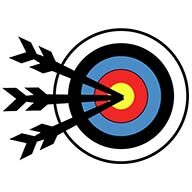By far, the most common bow type in archery is the recurve bow. This type of bow is used in target archery, 3D archery, field archery and even traditional archery. The recurve bow was invented around 1600 BC and was the primary ranged weapon in most armies for years. But you might wonder, what makes a recurve bow so special? What are the actual benefits of the recurved design? I will address this exact question in this article. Although I have written a detailed article about this question, you might just want a short answer to impress your fellow archers. So here we go:
The recurved limbs make the bow shorter and lighter and therefore easier to maneuver. More importantly, the recurve limbs are more effective in transferring the energy to the arrow. Therefore, recurve bows shoot faster than standard non-recurved counterparts.
If you really want to impress your fellow archers, you might want to know a bit more. Therefore, I will discuss how this works in more detail. But first we have to discuss some terminology and the history of archery.
Some quick terminology
Before we can dive into the details on why a recurve bow is such an awesome design, we have to discuss some terminology. Many archers often confuse these three words, since they are often used interchangeably.
Recurve
The definition of a recurve bow is very simple: ‘’a bow that has recurved limbs’’. This means that the points of the limbs point forward, when the bow is not drawn. Bows that do not fall under this category are longbows and flatbows. When not tensioned these bows are completely straight.

Take down recurve
The take down part in this word means that you can disassemble the bow. The limbs are removable from the riser, which makes your bow easier to store. Although many archers use the word take down recurve and Olympic recurve interchangeably it only refers to the disassembly of the bow. While Olympic recurve bows have other features to shoot in the ‘’Olympic style’’
Olympic recurve
Archers often paraphrase this word into recurve for multiple reasons. Within the archery community the term is often paraphrased because Olympic recurve archery, is quite a long word. When talking with people from outside of the archery community most archers also use recurve archery. When you say Olympic recurve archery, many people think that you take part in the Olympic games, which would be quite awkward.
The term Olympic recurve archery does only refer to the shooting style and rules from the Olympic games. Which means that archers that participate in Olympic recurve archery abide these rules and regulations. These set of rules restrict the use of let of, shoot trough risers and magnified sights. They do allow stabilizers, non magnified sights, adjustable arrow rests and plungers. If you want to know more about these differences, I recommend reading my dedicated article:
What is Olympic recurve archery?
A brief history of archery
The most primitive for of a bow is a longbow. Although the longbow is often associated with the Saxons and Britons, it was actually invented by the Egyptians. This type of bow consisted of a large round flexible pole and as string. Often it was just a young tree debarked and sanded until it was one constant pole. Therefore, these bows could be extremely heavy and where therefore often used by archers that trained their whole life to fire this bow.
The disadvantage of longbows is that they tend to be quite inefficient regarding power transfer. Meaning that not all of the draw weight was transferred in the speed of the arrow. The heavy draw weight also made it impossible for inexperienced archers to shoot this bow. The flat bow solved this issue, by flattening the bow limbs. This allowed the bow to be fired with a lower draw weight, with the same arrow speed.
The last archery invention from the ancient era is the recurve bow. Bow designers found that recurving the limbs, the bow would be easier to maneuver and shoot faster. For a comparison between the 5 most prominent bow types, see the chart below.
| Traditional archery | Modern archery | ||||
| Estimated date invention | 10,000 BC | 4000 BC | 1,600 BC | 1900 | 1970 |
| Bow name | Longbows | Flatbows | Recurve bows | Olympic recurve bows | Compound bows |
| Flat limbs | X | X | X | X | |
| Recurved limbs | X | X | |||
| Stabilizers | X | X | |||
| Sight | X | X | |||
| Plunger | X | ||||
| Adjustable arrow rest | X | X | |||
| Let off | X | ||||
| Peep sight | X | ||||
| Archers paradox | X | X | X | X | |
The advantages of a recurve bow
In the short answer of this article I discussed that a recurve bow is shorter, lighter and shoots faster than the non-recurved counterparts. In this section I will discuss how this works and how this helps you shoot more accurately.
Shorter
The first major advantage is that the bow can be a lot shorter, while maintaining the full draw length. Modern recurve bows can therefore be shorter than a longbow or flatbow. If you would flatten out the recurves in the bow, the length of the limbs would be about the same as a longbow. Wood and carbon can only stretch to a certain degree, if it’s stretched too far it will start to break. Therefore, you simply need to spread the force over a long bow. By making the limbs recurve, the bow becomes a lot shorter, while still spreading the force of the draw weight. In ancient times this made it possible to shoot a bow from horseback, which was very unpractical with a longbow.
Faster
When an arrow is fired, not all the energy from the draw weight will be transferred in forward motion in the arrow. Bows are not 100% efficient in the energy transfer, just like electrical equipment. A light bulb will for example always create heat. Although LED lights are way more energy efficient, also these lights create heat thereby losing some of its energy. This is the same with bows, different bow designs have different efficiency ratings.
When a bow is fired, the part of the limb that travels the longest distance are the tips. A smart design feature of recurve limbs is that they will make it much easier to accelerate the tips. Since the tips of the limbs are attached to the string, this will mean that more energy is transferred into the arrow. Therefore, less energy is lost, and more is transferred into the speed of the arrow. If you would compare a recurve and a longbow with a similar draw weight and arrow you should find that the recurve bow shoots a lot faster. The recurved design is, therefore, just a more efficient design to transfer the energy to the arrow.
Lighter
Since recurve bows are more efficient, the bow can be made a lot thinner, since less draw weight has to be stored. This not only decreases the draw weight of the bow; it also decreases the overall weight of the bow. This makes recurve bows a lot easier to wield while requiring less muscle strength.
Final thoughts
You now know why most archers prefer a recurve bow, and why it was used in most ancient armies. It is not only easier to wield, but it also is a more efficient design. I hope you found this article interesting. If you have any comments or questions, please leave them in the comment section down below. I will respond as soon as possible
If you are an expert in thermodynamics and you spotted an error, please let me know. I am not an expert in this field, but I tried to be as accurate as possible. I wrote this article from different sources and academic literature, so I could always make mistakes while interpreting results.
Tim van Rooijen
For as long as I can remember, I have always been fascinated by archery. First due to its historic significance but later because I like being outdoors. With this blog, I share my knowledge about Archery and how you can improve your shot. More about author…

